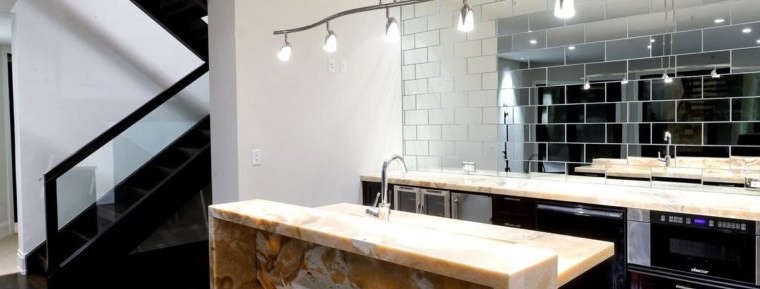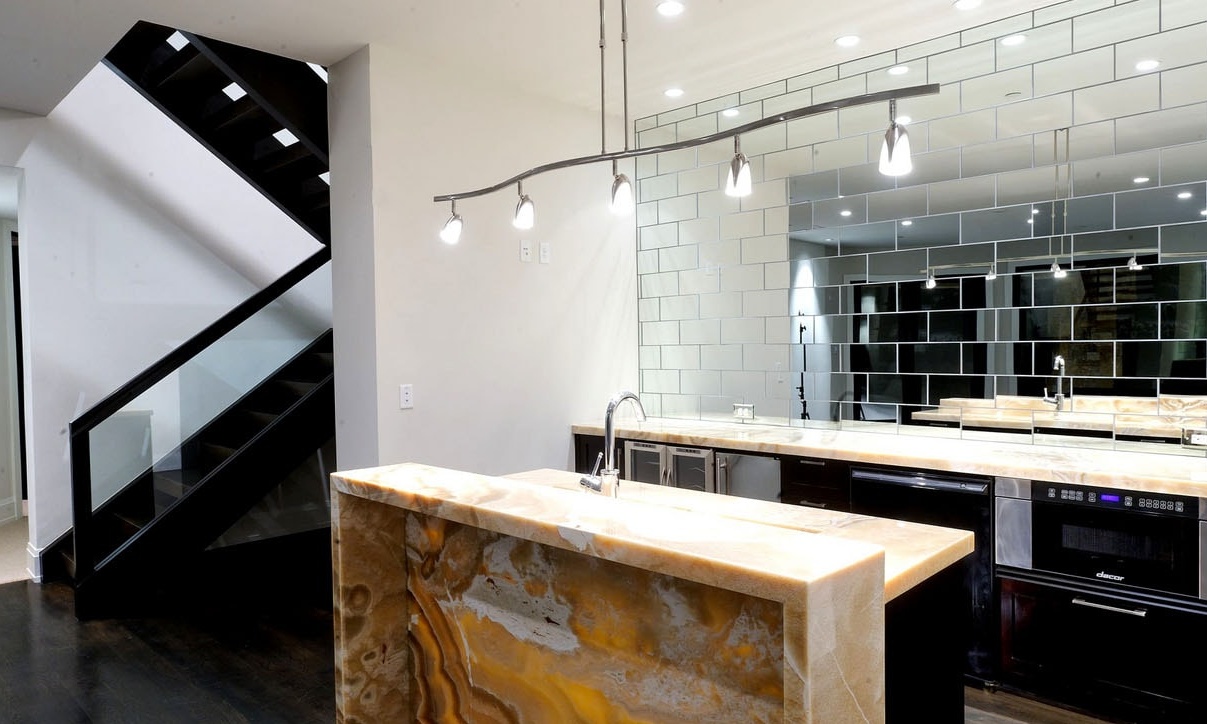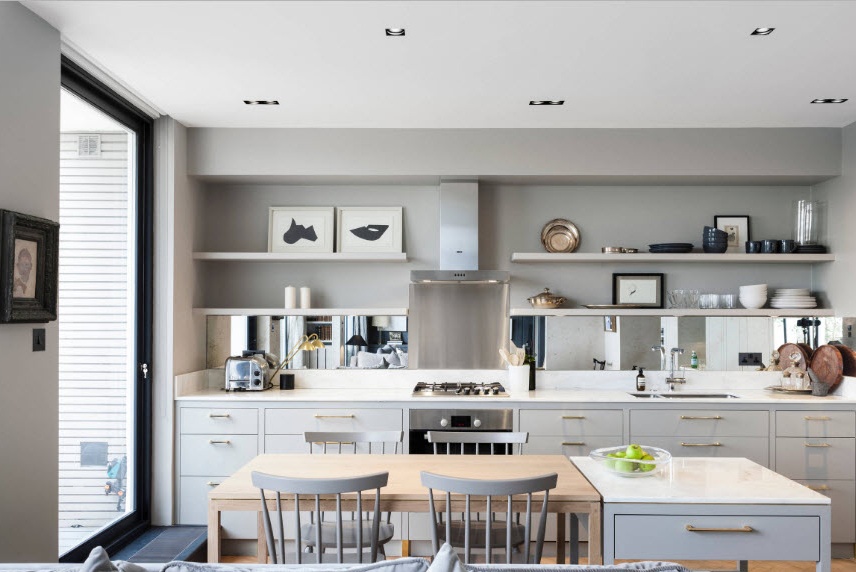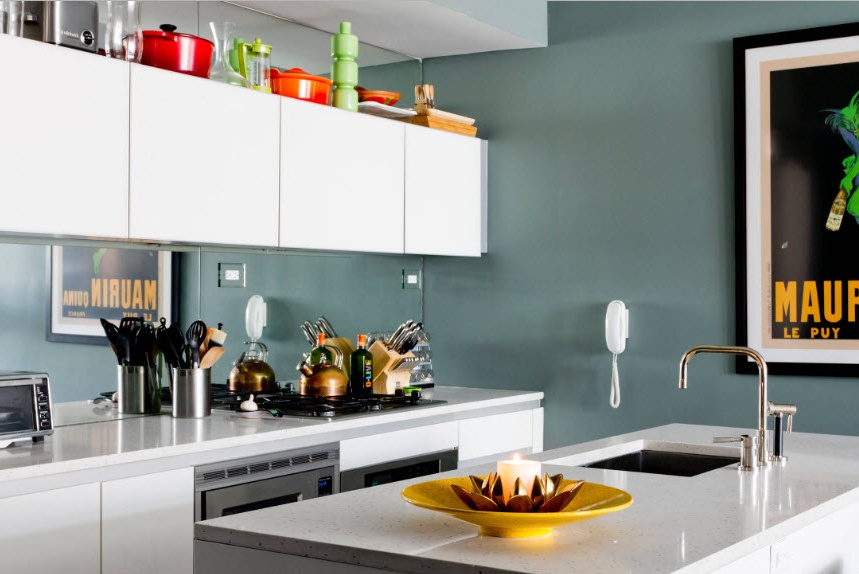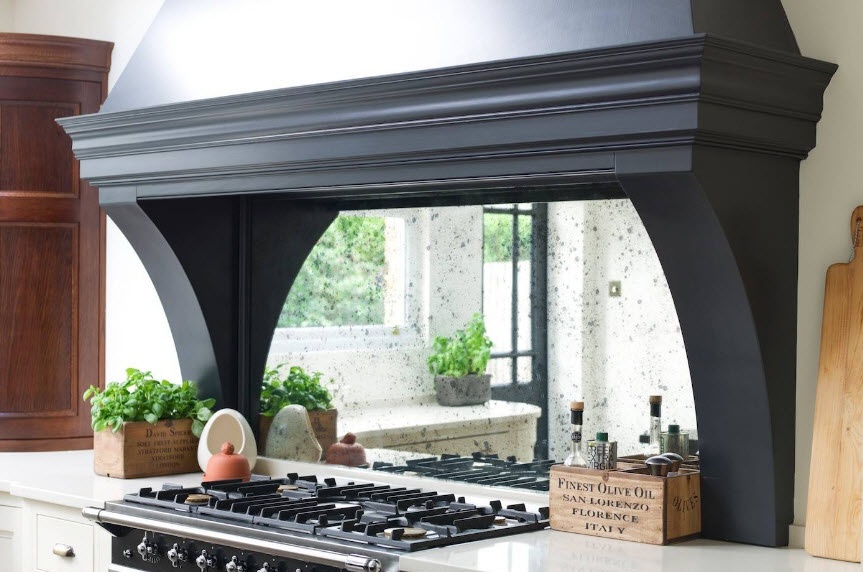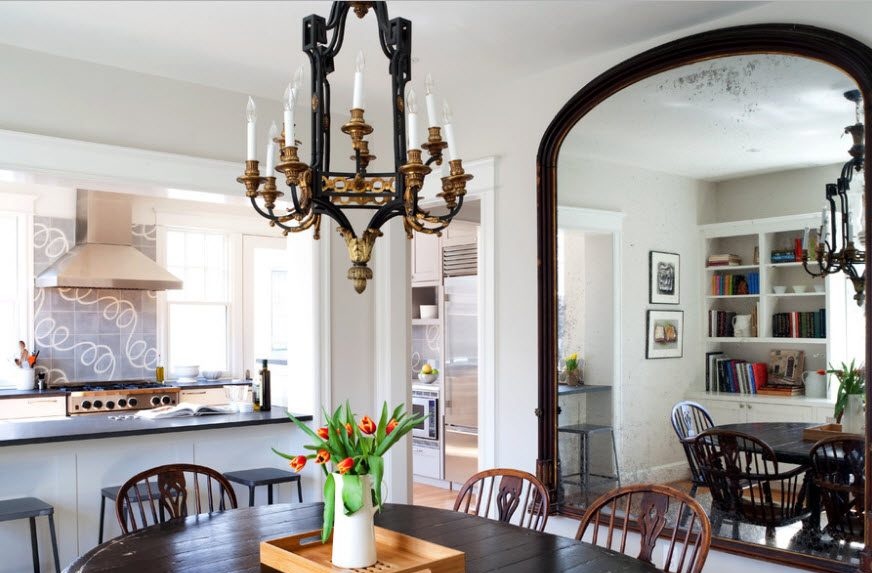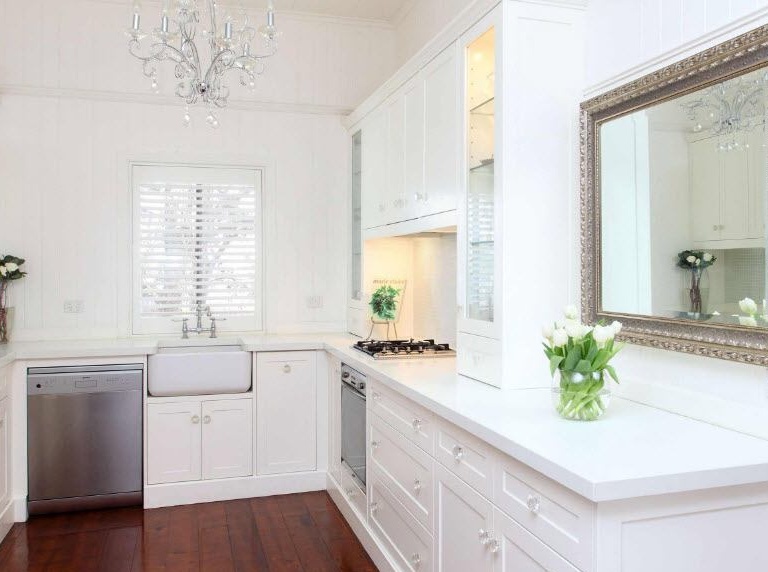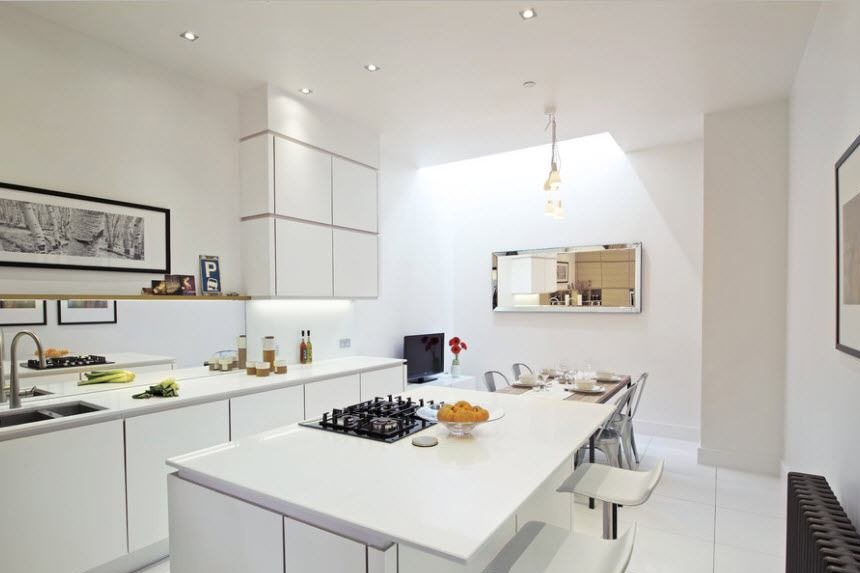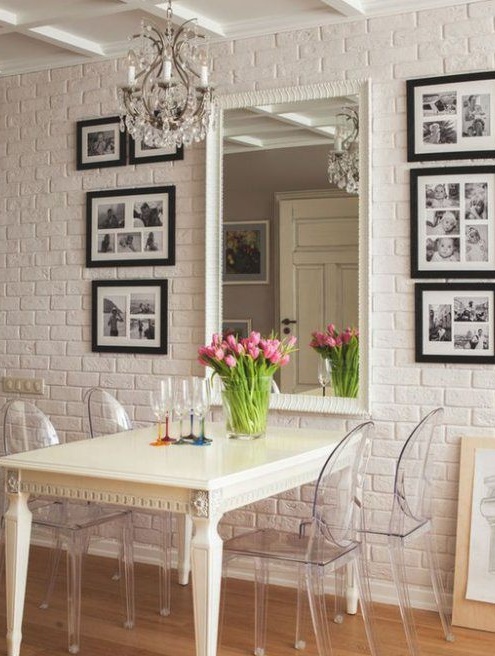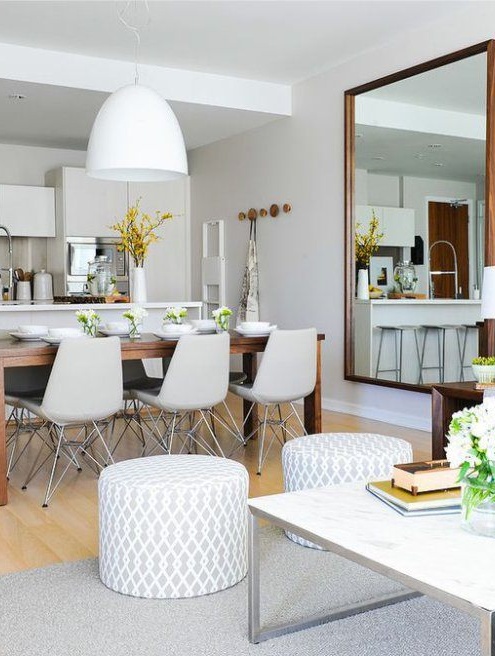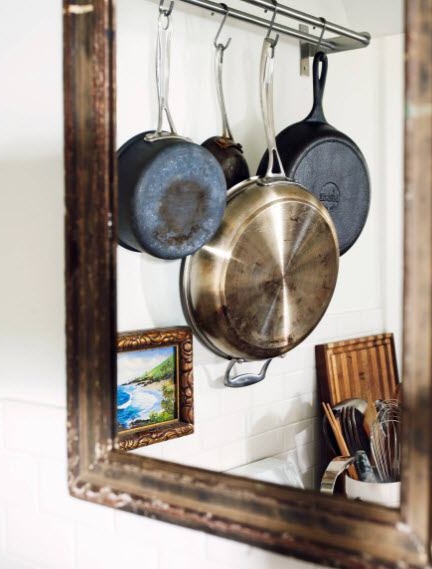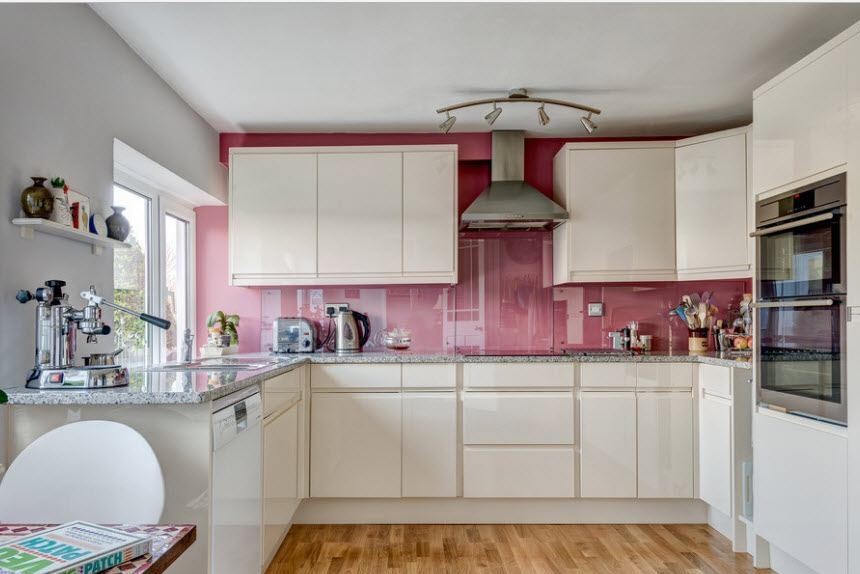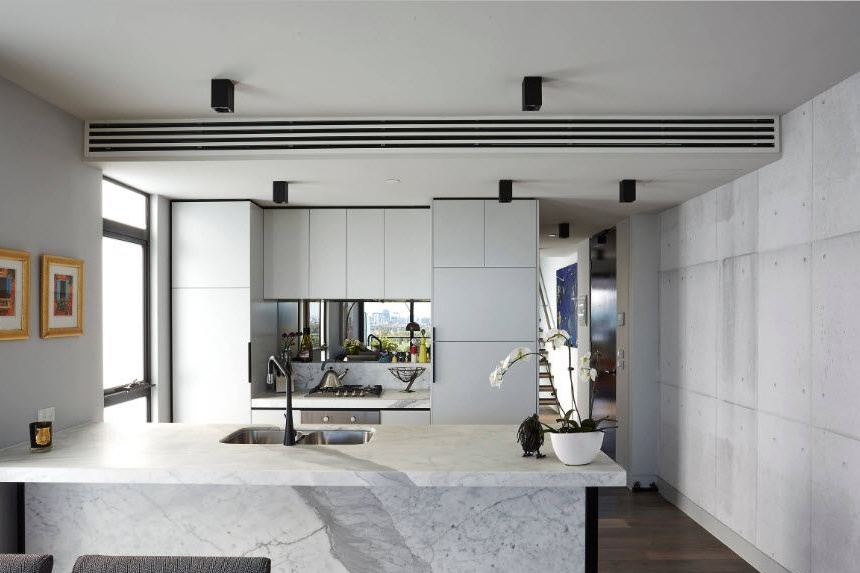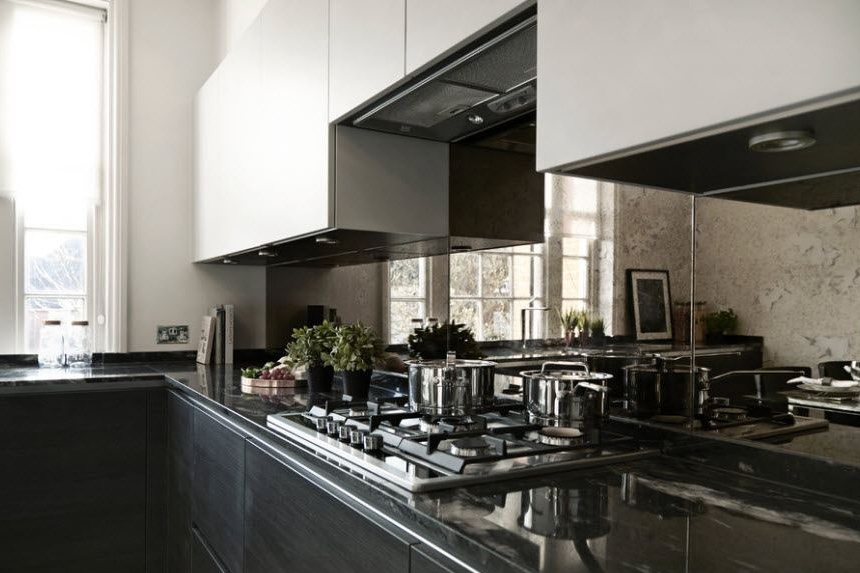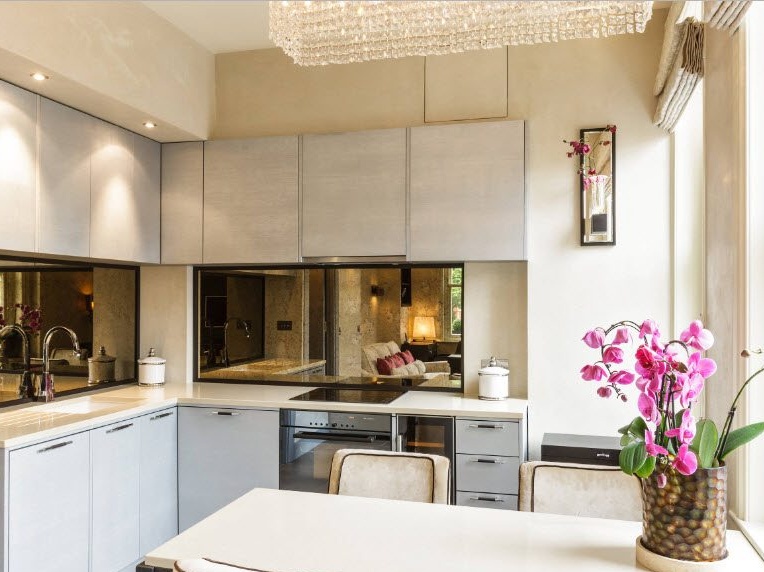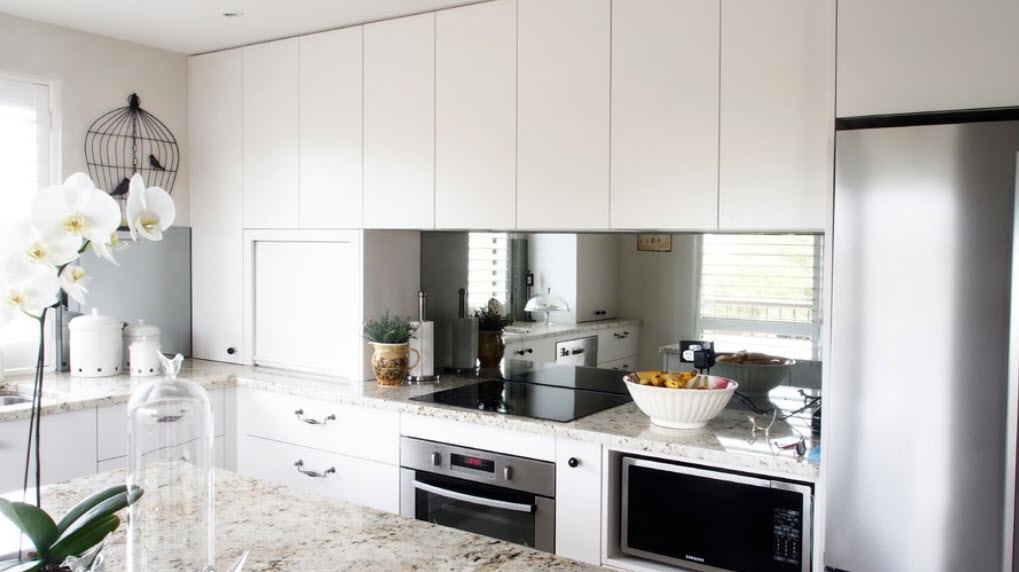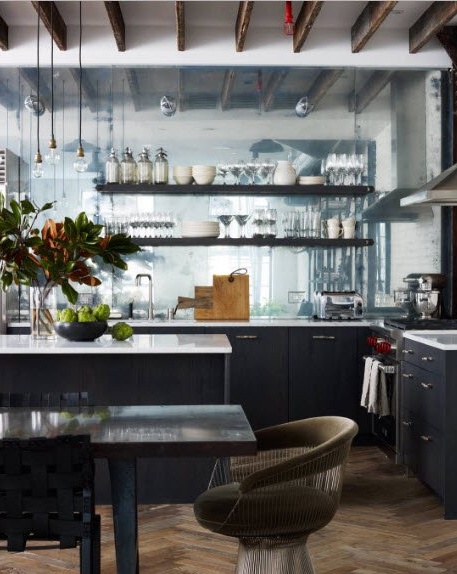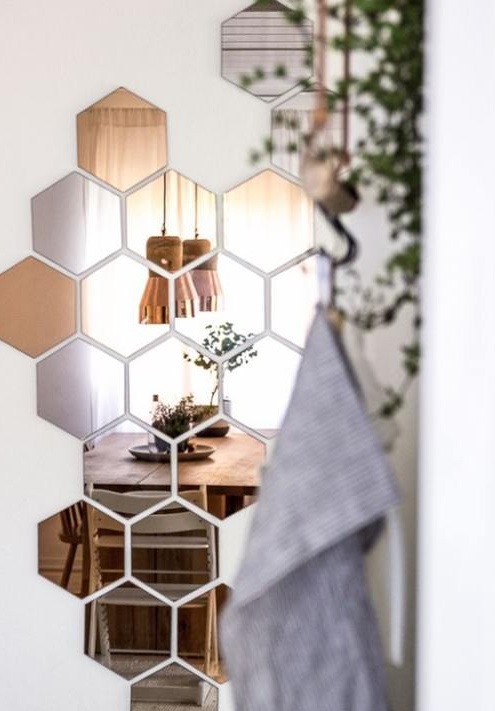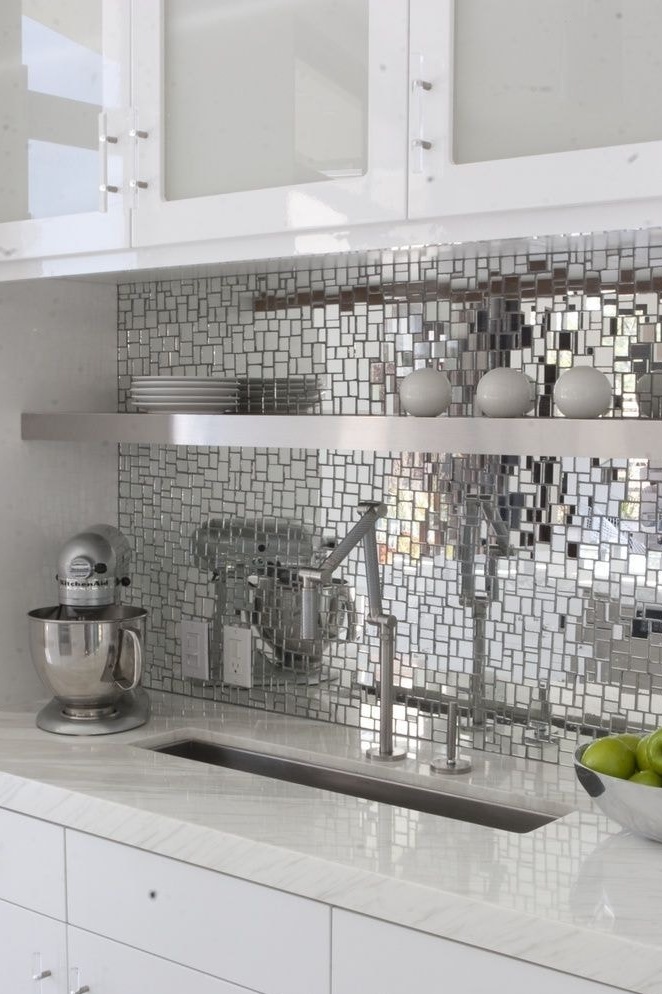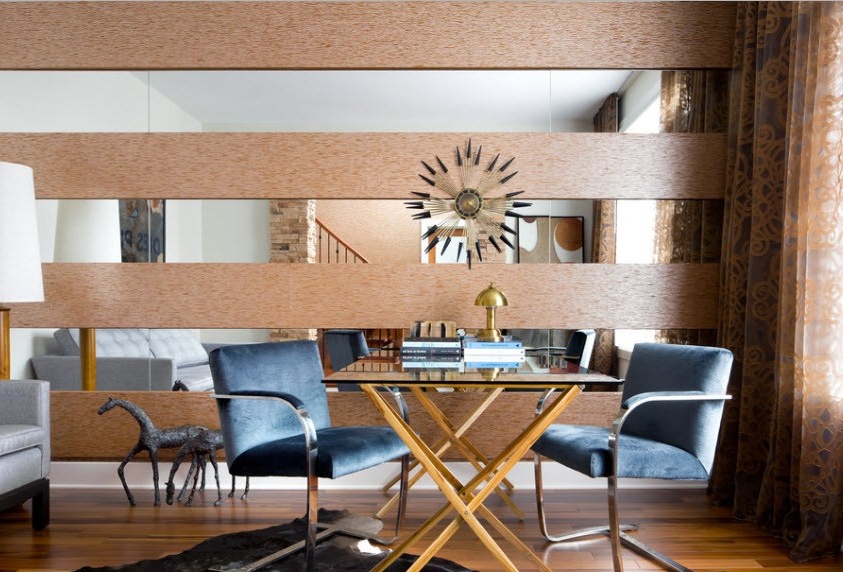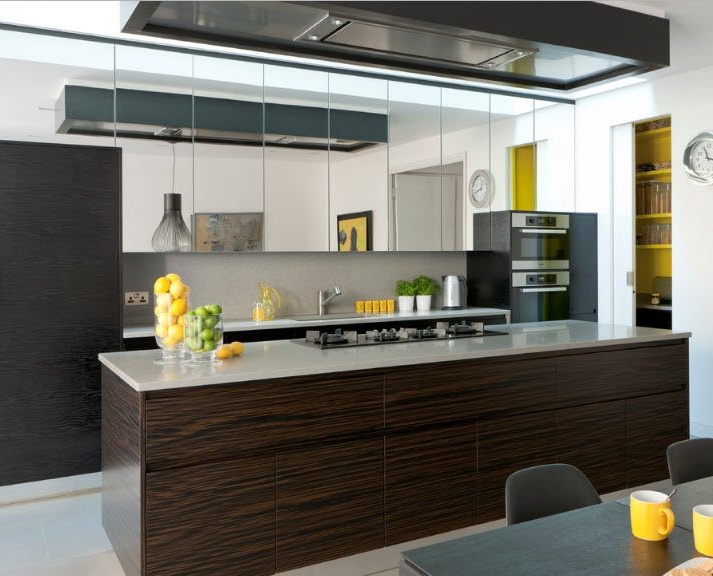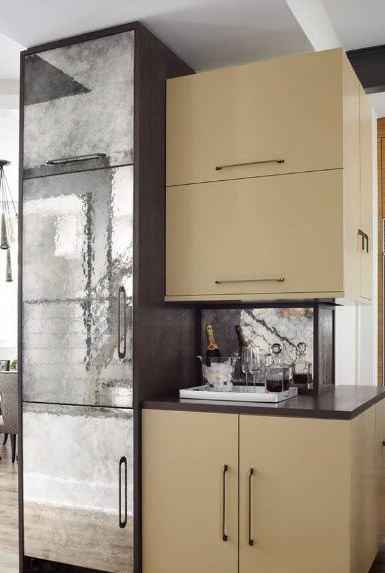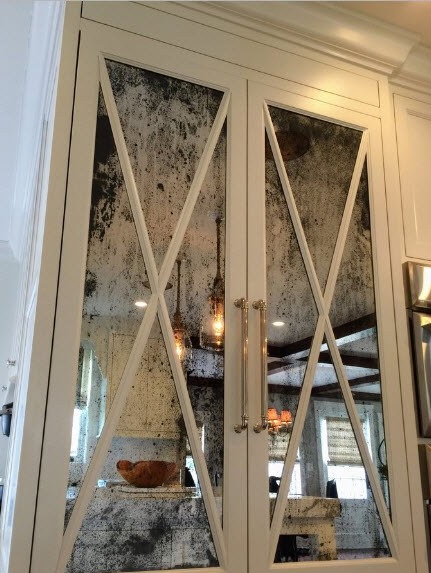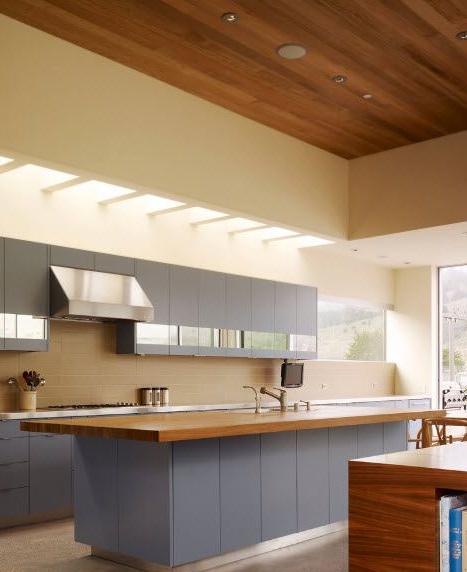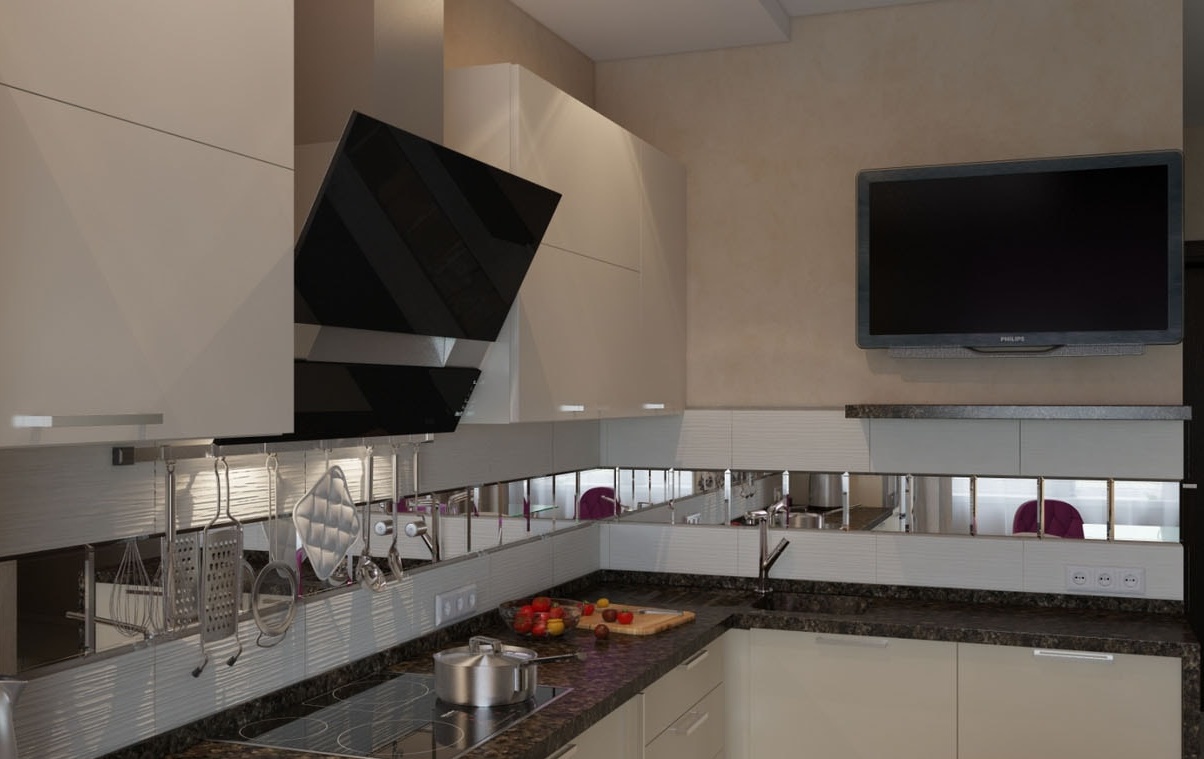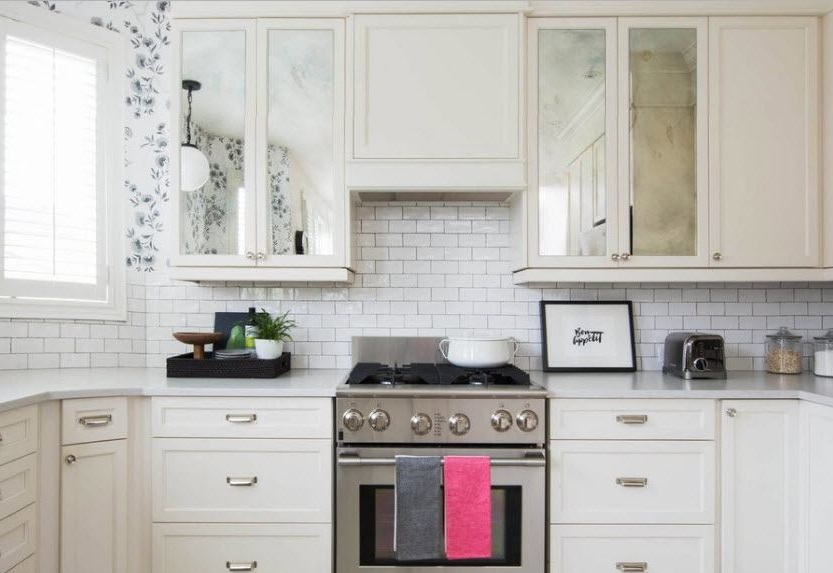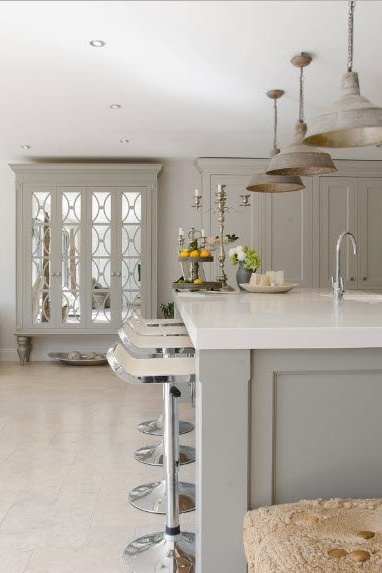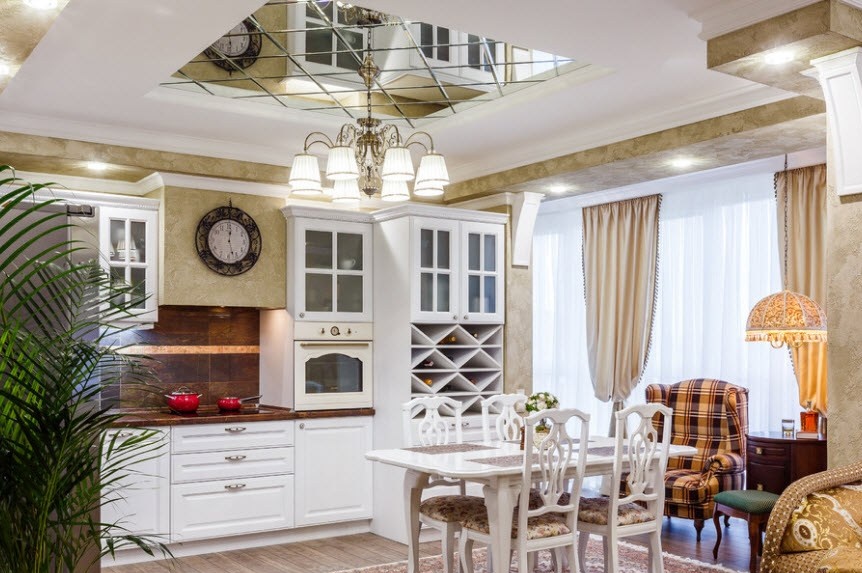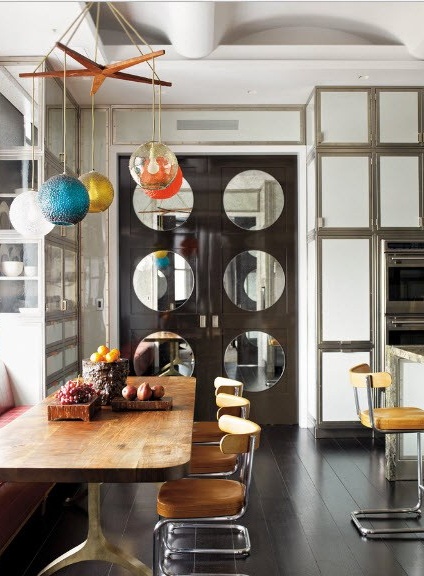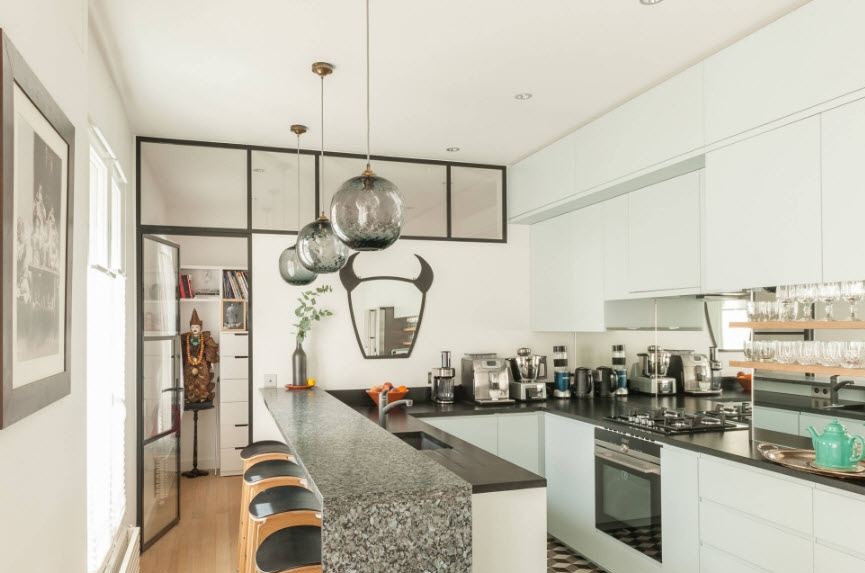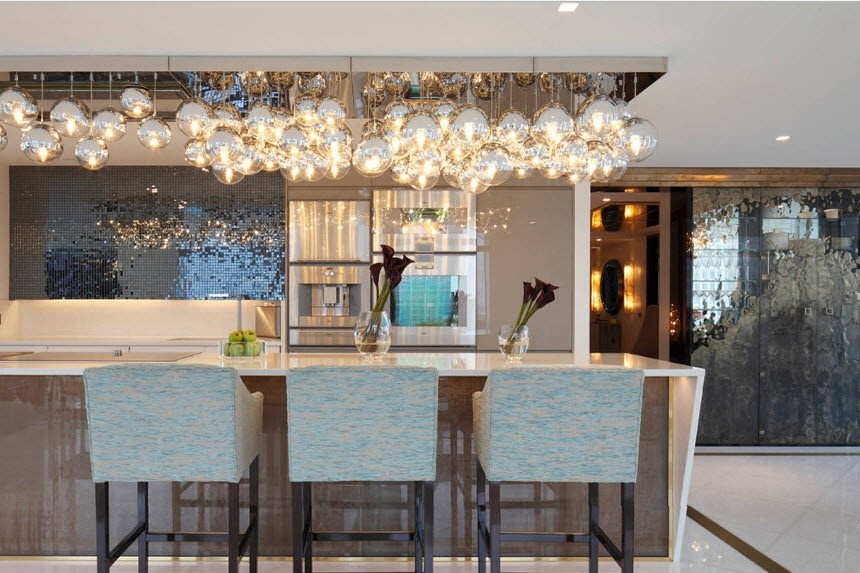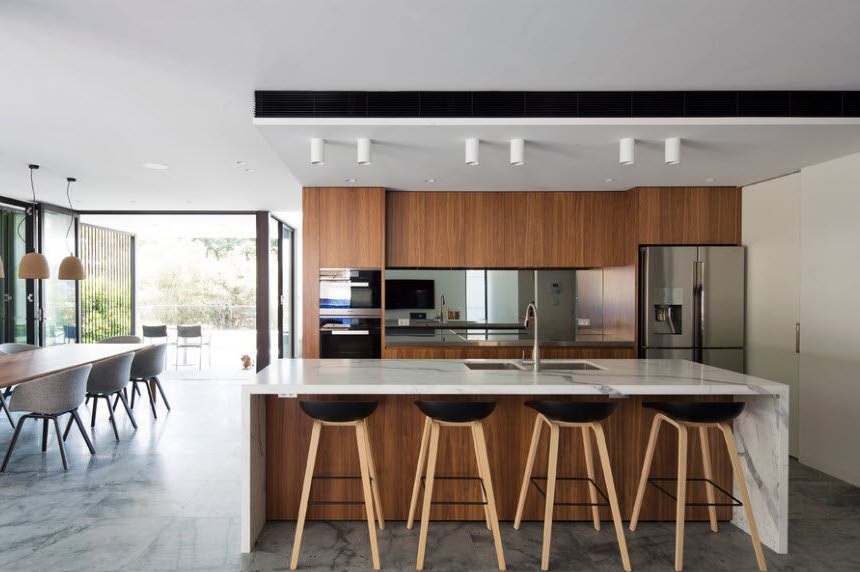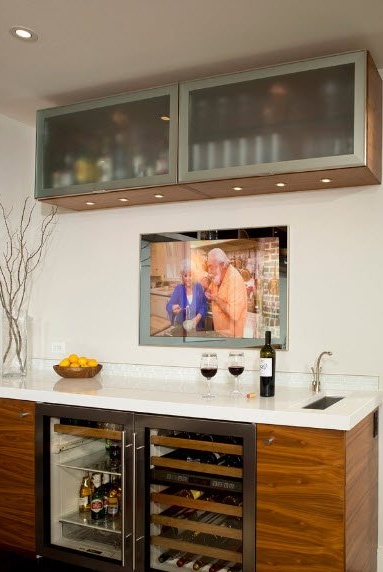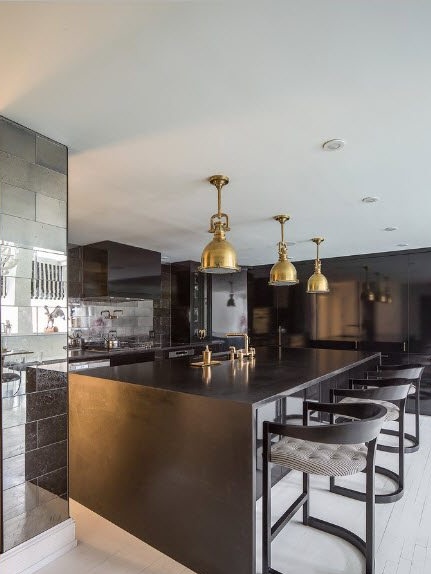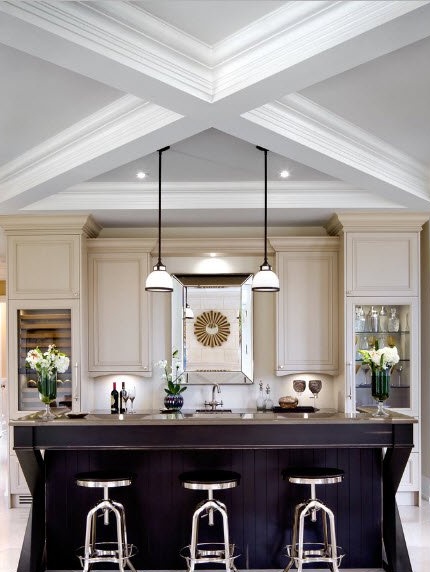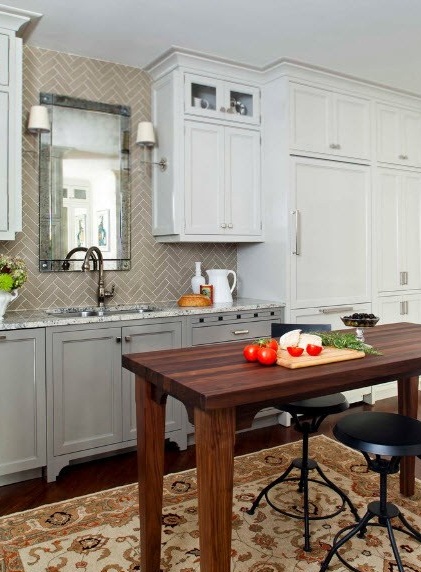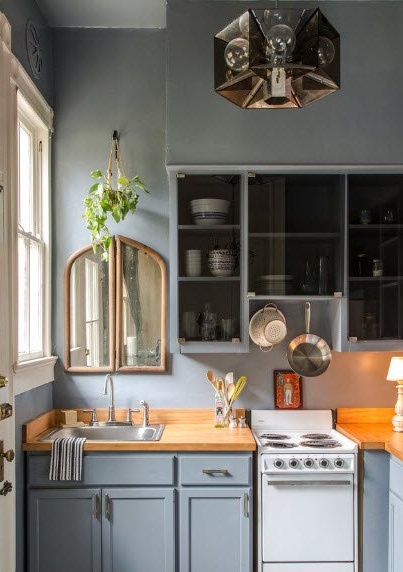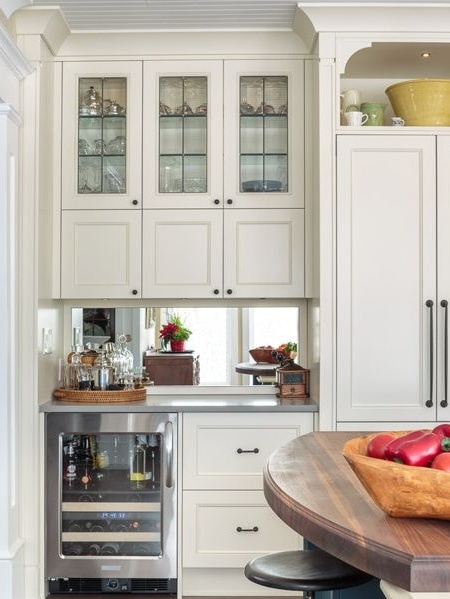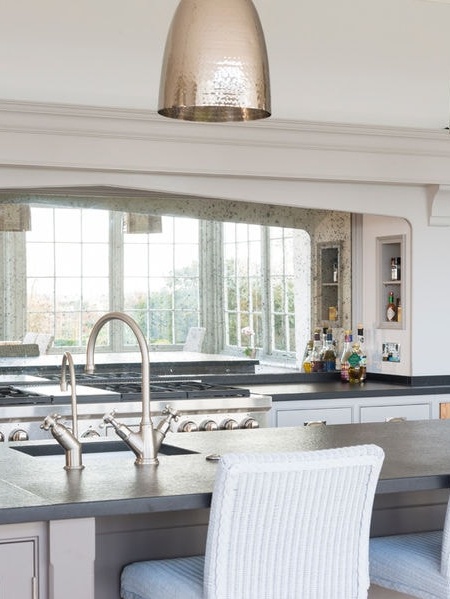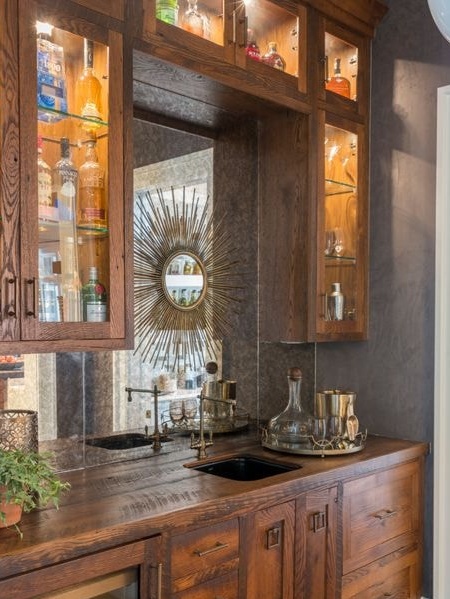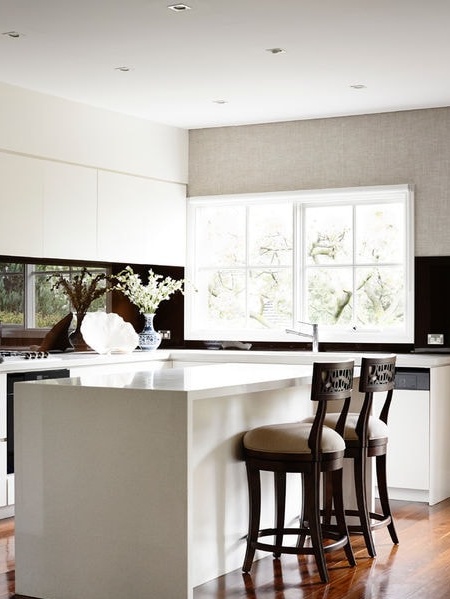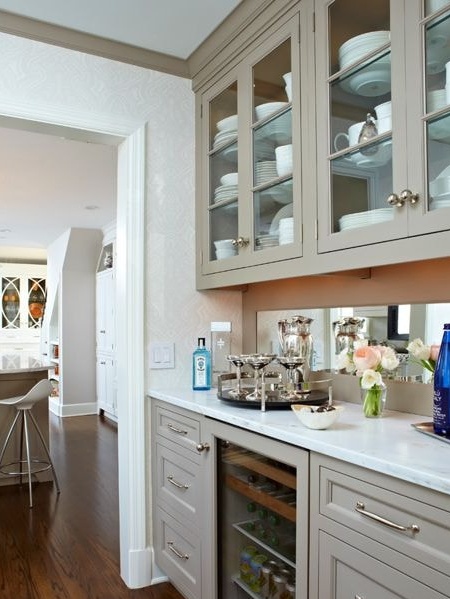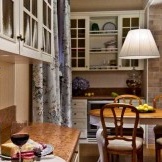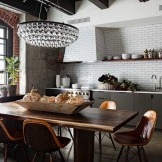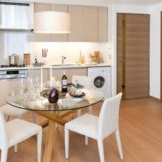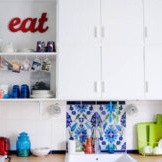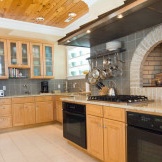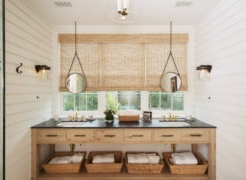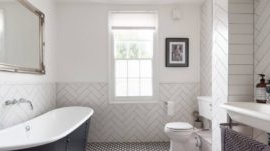It is difficult to overestimate the functional and aesthetic properties of mirrors: this is the ability to add the missing volume to the room, and increase the light in the interior, visually transforming the space. Like any reflective surface, the mirror has the peculiarity of representing the room in a mysterious and bewitching appearance. How much does the kitchen need this “secret"?
A mirror in the kitchen interior of a typical Russian apartment is an unexpected phenomenon. But just the majority of kitchens, especially small ones, make the mirror more advantageous. Of course, each interior needs its own individual approach. Somewhere reflective surfaces are simply necessary, but somewhere will be completely redundant.
Modern mirror decoration offers a wide selection of shapes, dimensions and color characteristics, so it’s easy to find the right option for a particular kitchen interior.
Material
Mirror structures can be made on the basis of glass, acrylic material and polystyrene. The latter is better not to use in the kitchen, as it is afraid of moisture and unstable to mechanical damage. Therefore, we dwell in more detail on the other two options.
Acrylic. Such mirrors are highly stable and are considered the safest. Additional advantages - ease of installation, transportation and cutting. The disadvantages include high cost and scratch susceptibility.

Glass. Such models are heavier than acrylic and are used for kitchen aprons and wall decoration.

Based on such structures, the following elements are produced:
- mosaic tile - used for wall cladding, apron and some elements. This finish has a number of advantages: the invisibility of spots, stains, the optionalness of a flat base, the possibility of local repairs, a spectacular aesthetic component. Among the minuses, one can single out a high price and the need for periodic cleaning of the seams;
- sheet panels - usually used for decorating walls, aprons, furniture facades. Their thickness varies between 4-6 mm;
- Tiles - can be of various shapes (squares, triangles, hexagons, etc.) and sizes.



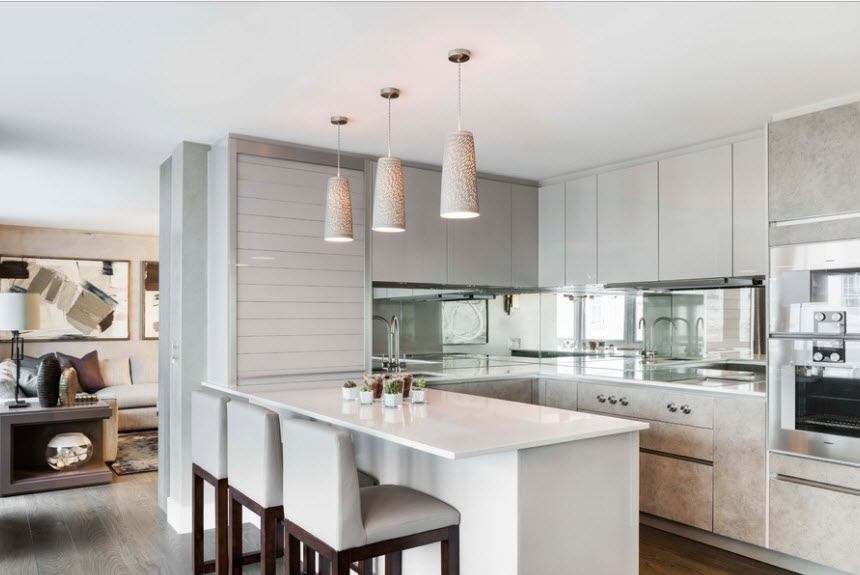
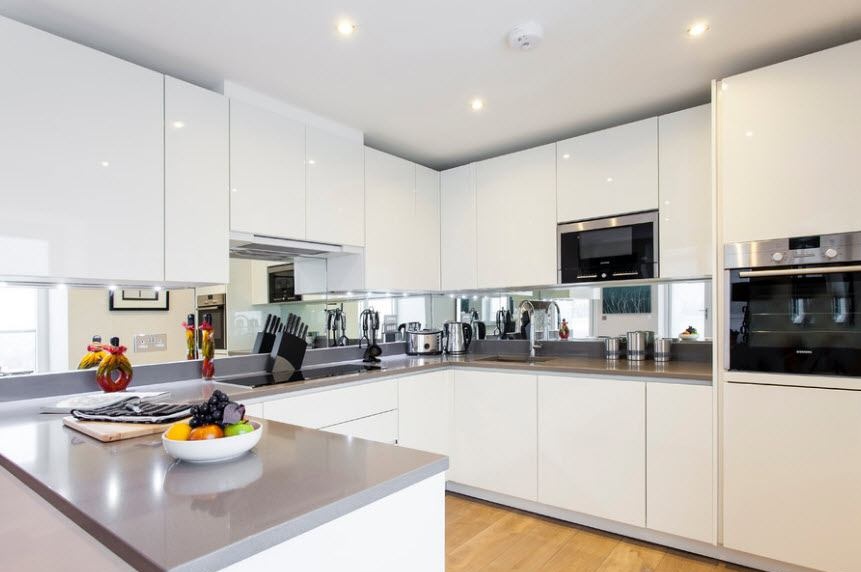
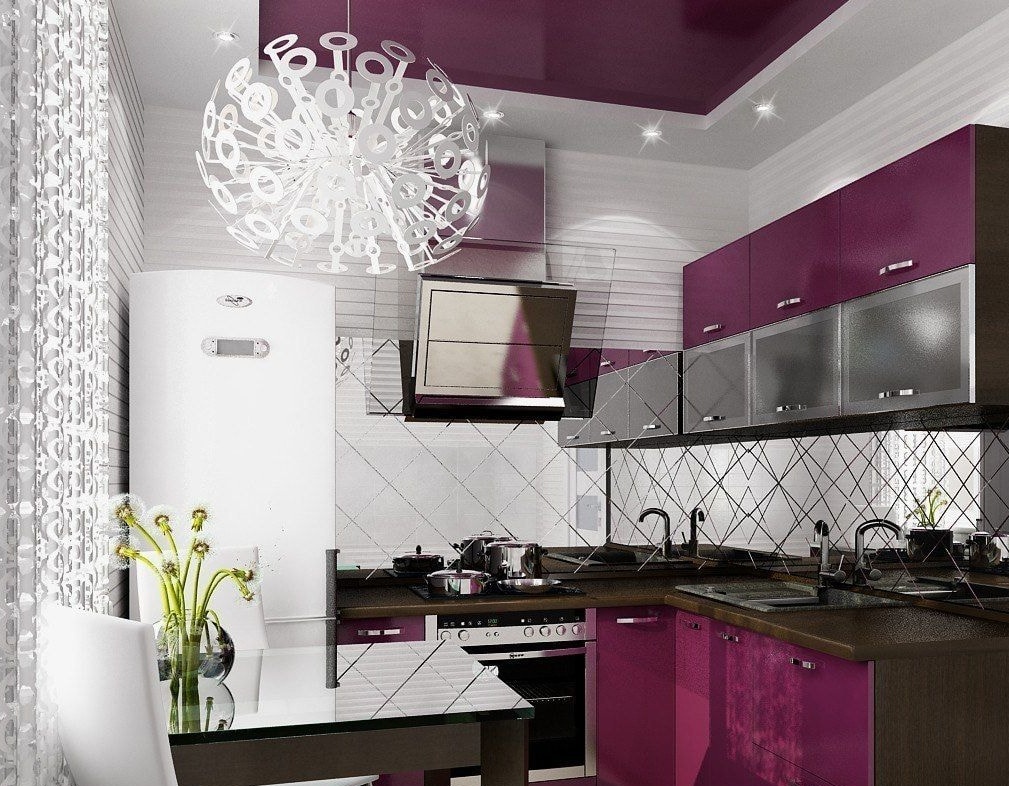
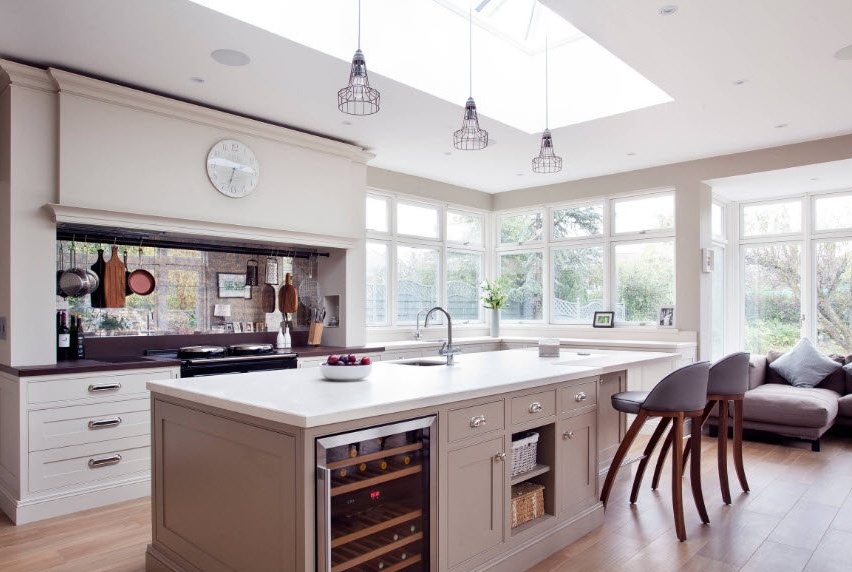
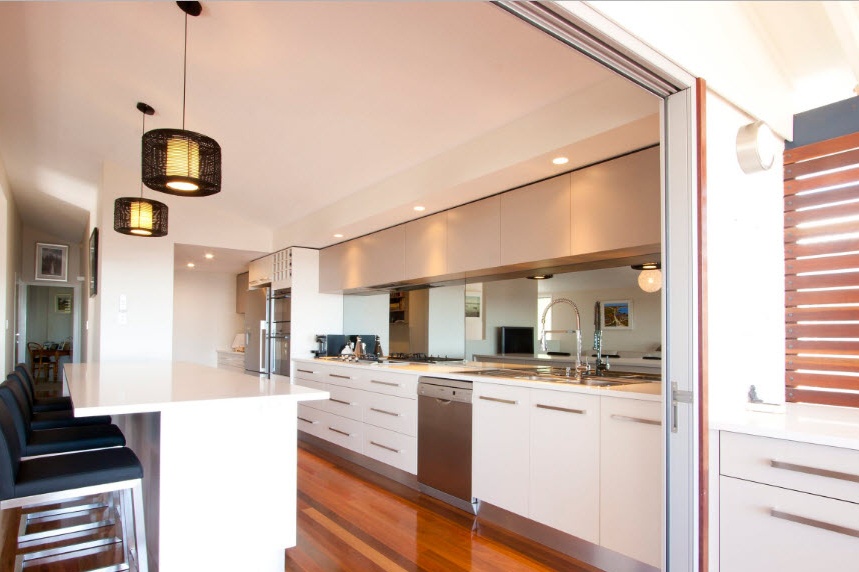
Edge options
Edge is considered one of the most important elements of mirrors. Its edges do not include processing, which makes the product more vulnerable. It is worth choosing designs with a polished edge or a facet (edges, beveled at an angle). The second type is characterized by durability and strength. In addition, the product has an amazing sheen due to the refraction of light.

Mirror Design
Colored design - can be decorated with the colors of gold, graphite, champagne. Often used mirror designs in red, green, blue, purple, due to the painted base of glass.

Satin is a type of frosted product that is achieved by chemical etching. Similarly, they can highlight a picture or the entire canvas. The external effect resembles sandblasting, but it looks more smooth, elegant.

The effect of antiquity - a kind of visualization of a cloudy surface, is performed by printing under an amalgam or chemical etching. These mirrors fit perfectly into classic kitchen interiors, giving them a special charm.
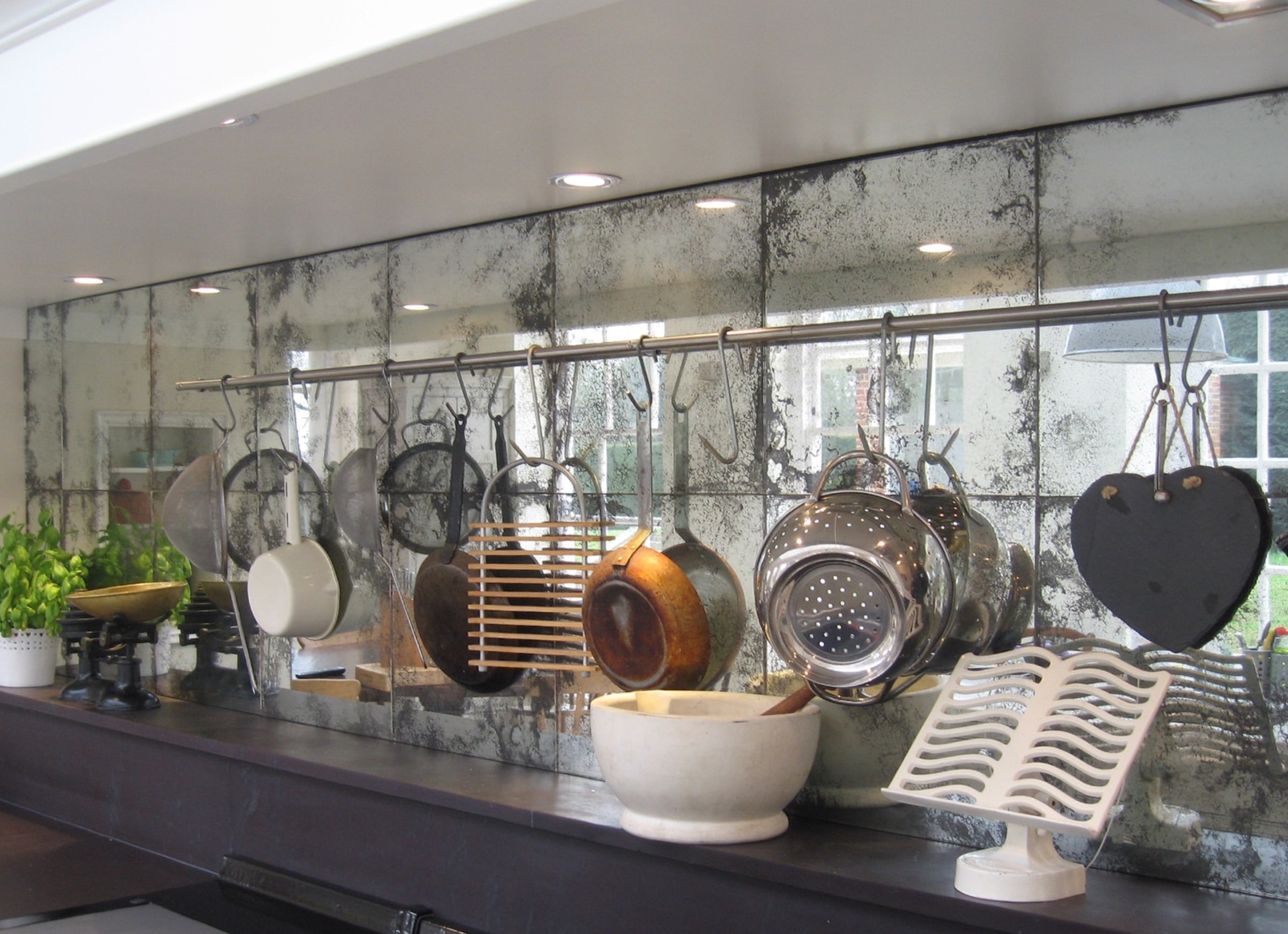
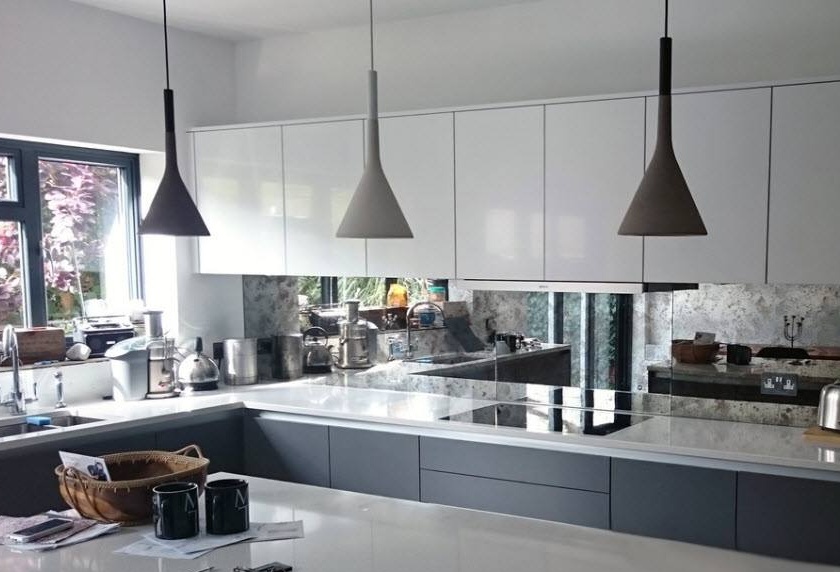

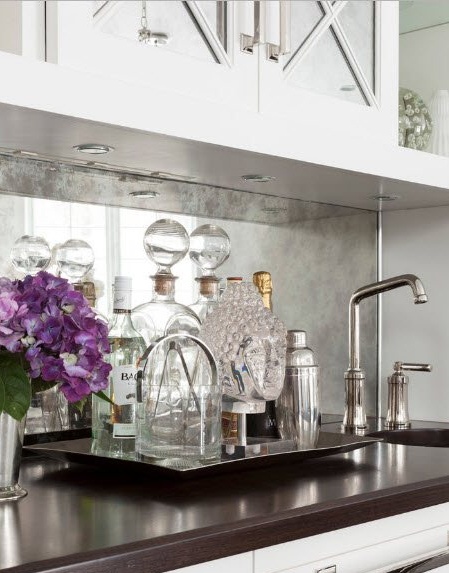
Sandblasting - this finish involves applying a pattern to the outside of the product. Thus, the effect of hoarfrost is achieved. For such a design, a frame is required. Definitely, this is not an option for facing an apron, since such a mirror requires very careful handling.
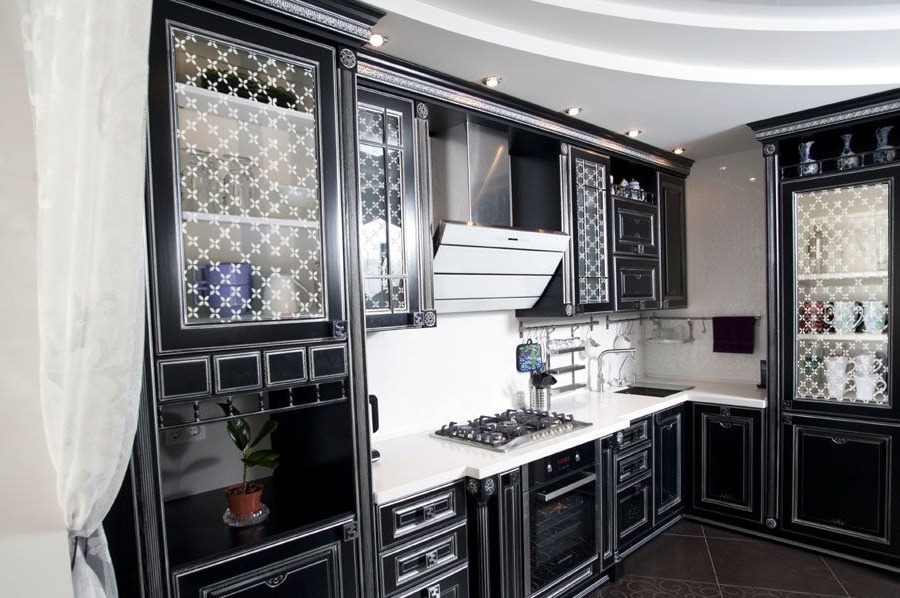
Pattern under the amalgam - the mirror is decorated with any desired pattern. The image is applied to the film by ultraviolet printing, which is subsequently glued to glass and coated with an amalgam.
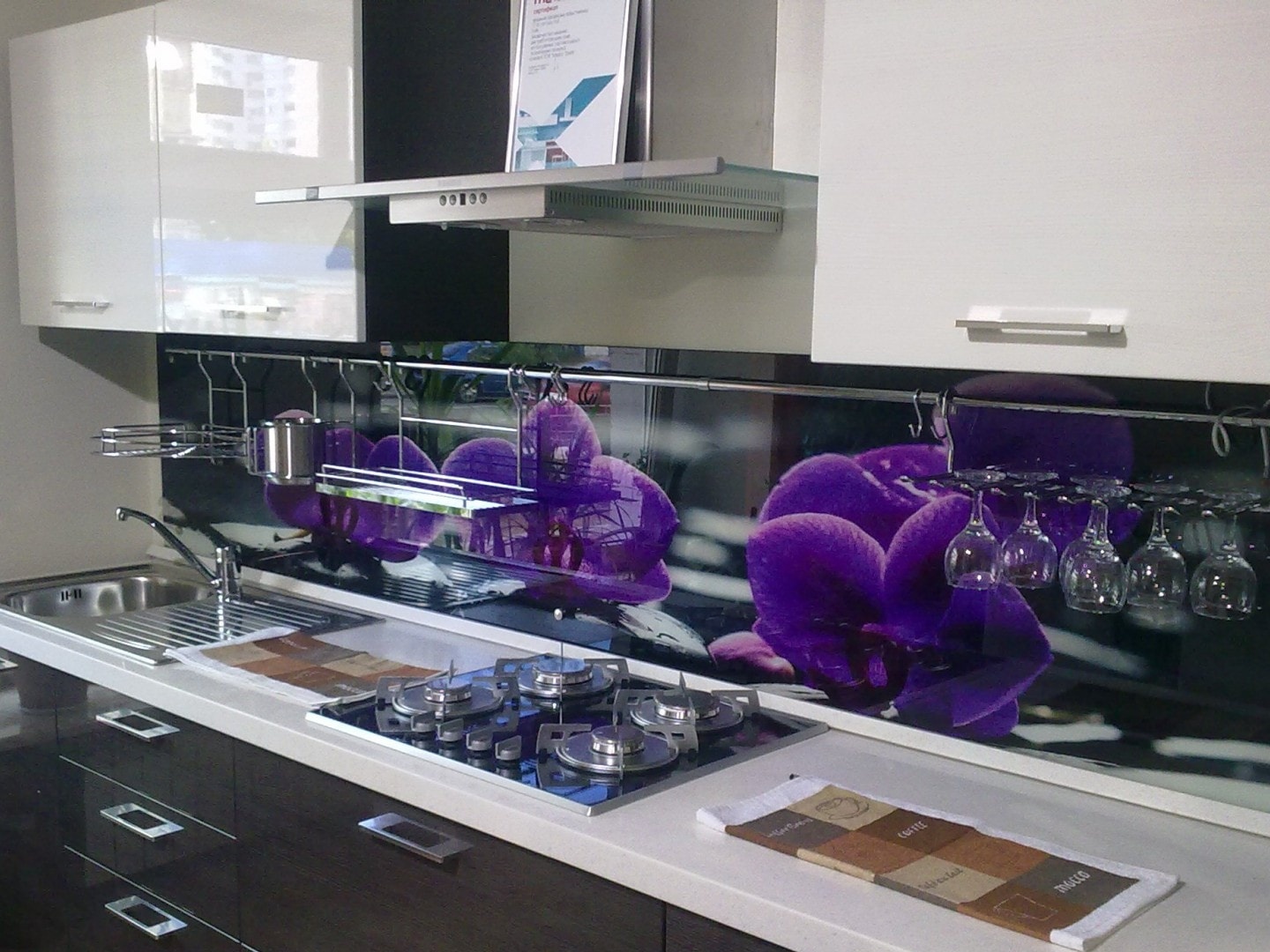
Care and practical use of mirrors in the kitchen
How practical is a kitchen mirror? It all depends on the lifestyle of the owners and what goals you want to achieve. On the one hand, the mirror is not afraid of water, acids, alkalis and soft brushes. Dirt and greasy stains can easily be washed off its surface. On the other hand, such a product requires regular cleaning, because the desired effect from it is possible only in its pure form. And the key role in this regard is played by the location of the mirror surface. So, for example, a mirror apron is an option for those who very rarely cook, or for those who are not afraid of frequent cleaning. But if you hang a mirror in the dining area, it is enough to wipe it 1-2 times a week.
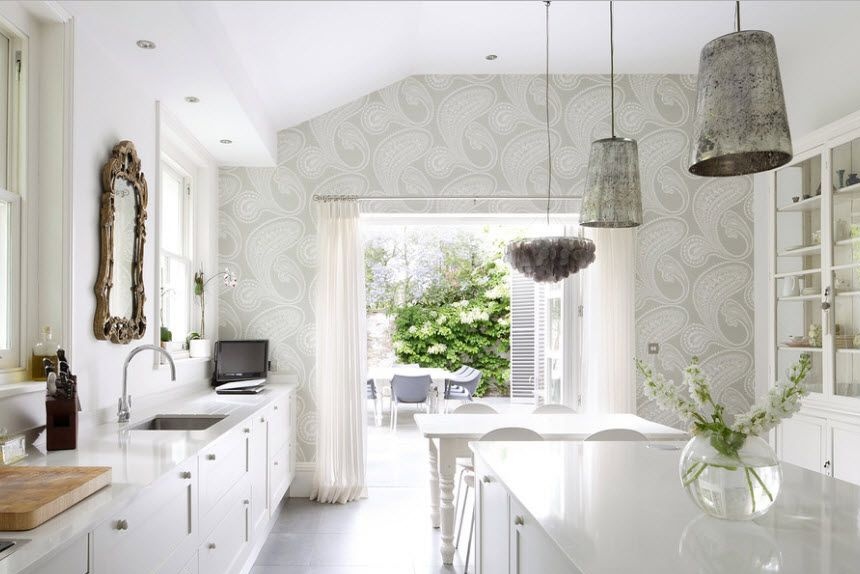
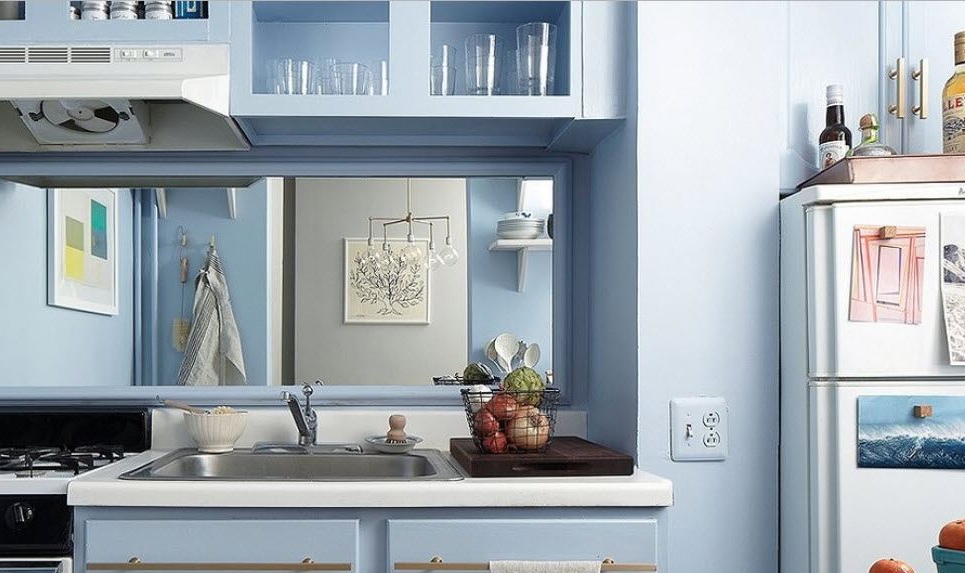
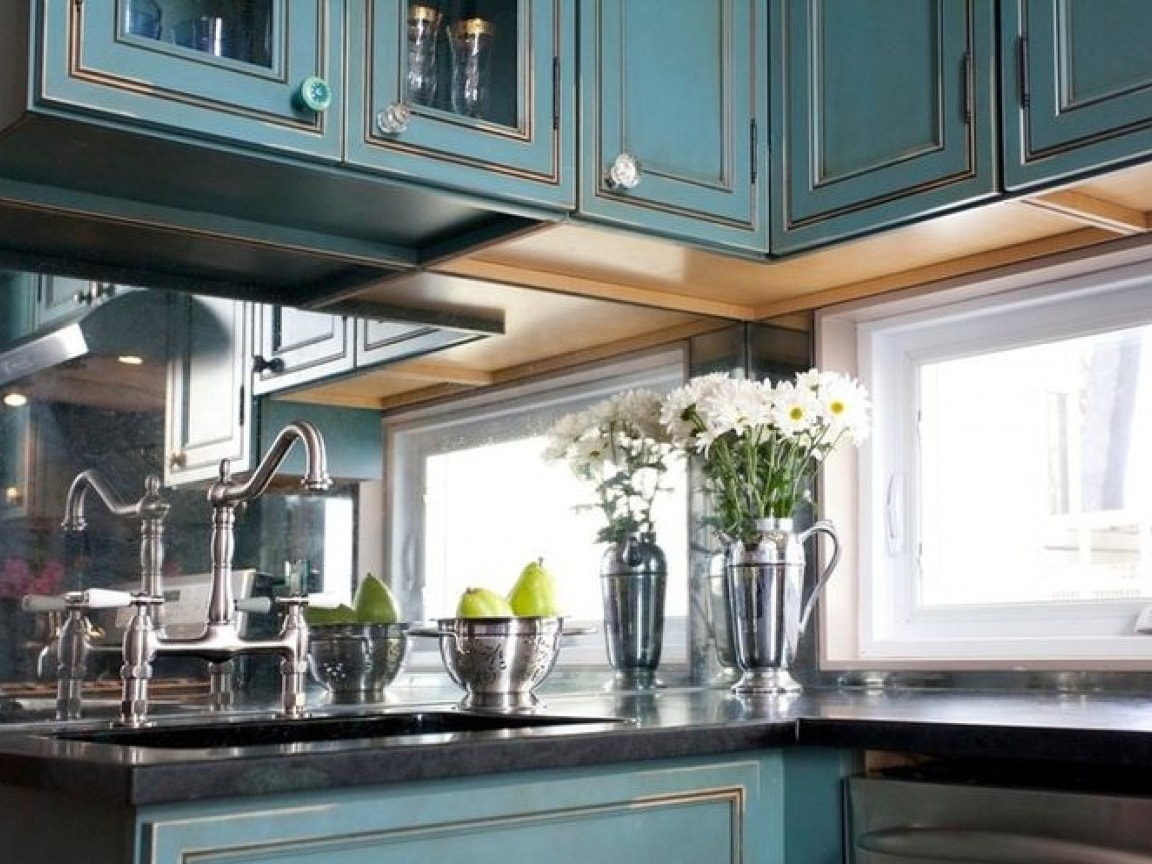
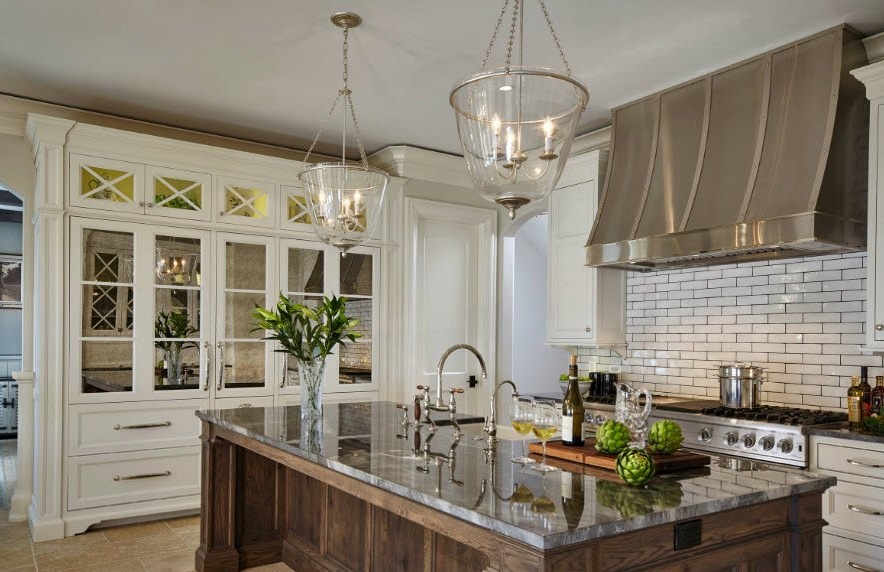
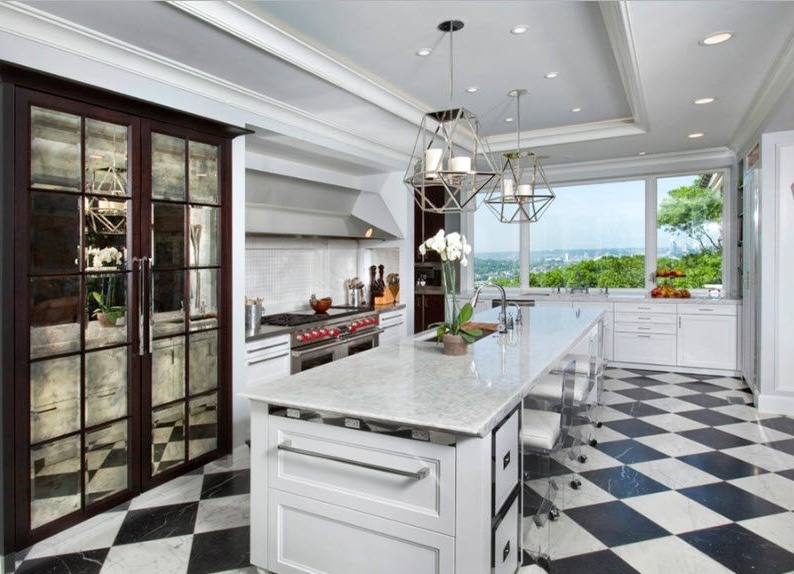
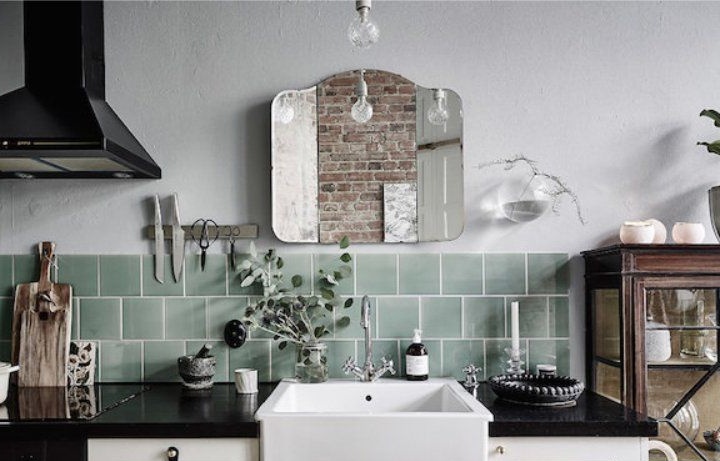
Application Ideas
1. Wall mirror
Perhaps the most classic option is to hang a mirror on one of the walls of the kitchen. Such a decision will brighten up the traditional “dining room” of the room, make it more refined and sophisticated. The only point, again - the optimal location, which will depend on the specifics of the life of the owners. This was mentioned above.
Note: according to Chinese ancient philosophical teachings, feng shui in the mirror in the kitchen should reflect the cooking area or a richly laid table. In the first case, it will bring convenience and comfort to the hostess, in the second - it will attract wealth and prosperity.
Consider several options for such a solution:
3. Mirror instead of cabinets
If the wall is not cluttered with upper cabinets, then the mirror can quite successfully take their place. You can place neat open shelves on top of it, but remember - reflections in this case will double the contents.
4. Mirror on the whole wall
Ideal for a small kitchen, allowing you to expand the boundaries of the room and permanently get rid of the effect of a confined space.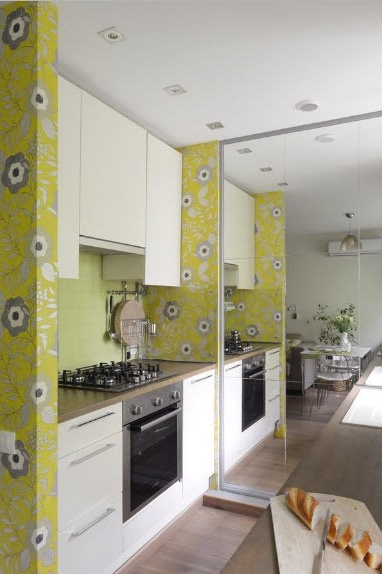
The main advantage of mirror facades is that such furniture almost disappears in the interior. It seems that there is no furniture in the kitchen at all.
But a significant drawback is the soiledness inherent in all glossy surfaces. In this case, you can choose an alternative and more practical place for a mirror surface - these are the facades of the kitchen island.
Another great trick is to order embossed or aged mirror paintings that won't look covered with fingerprints and beg for cleaning.
6. Additional mirror elements
Choosing a place for mirrors can be original and the most unexpected. The mirror base at the base of the cabinets is a non-trivial solution for a conventional kitchen.
7. The composition of the mirrors
For such an idea, you can choose the same or different-sized mirrors. The main thing here is harmony. Think of a uniting element, such as frames in the same color or style. For a more spectacular decor, make the composition boring, ironic - pick up mirrors of different shapes or arrange them dynamically.
8. Mirror inserts on the facades
Such a solution is advisable only for cabinets of the lower or upper tier, where contact with water (greasy spray) is excluded.
9. Mirror above the head
Undoubtedly, such a spectacular decor will contribute to the design, give the room luxury and charm, but not every kitchen will fit.
10. Mirror door
Mirror inserts on the door or a single panel will expand the space, and the door will quietly “hide” in the wall. Agree, the reception is straightforward, but quite interesting.
11. Mirroring technique
Modern manufacturers of kitchen appliances have long taken care of the design and released mirror-coated appliances. They do not look so bulky and much more aesthetic than their analogues of the familiar design.
A universal solution for simultaneously two tasks: the stylistic design of the kitchen and the location of the TV screen.
More design options for the kitchen interior are presented in the following photo selection.






